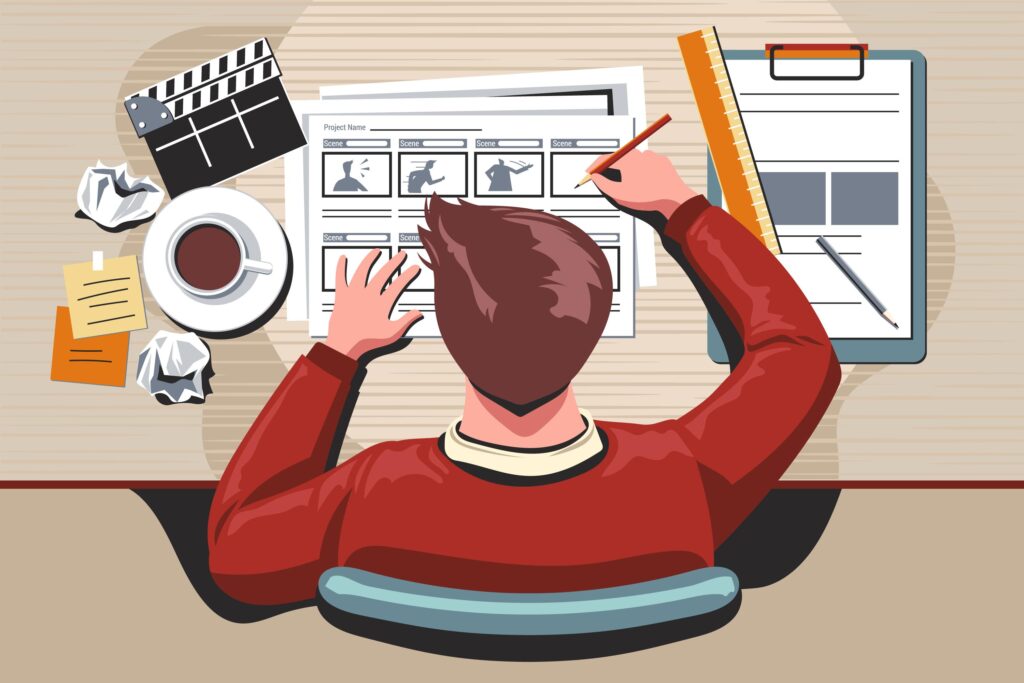Why is Scriptwriting And Storyboarding For YouTube

Why is Scriptwriting And Storyboarding For YouTube
Why Scriptwriting and Storyboarding are Vital in the Creative Process
Why is Scriptwriting And Storyboarding For YouTube Scriptwriting and storyboarding are two fundamental aspects of the creative process that play a vital role in shaping narratives and visualizing ideas. Whether it’s a blockbuster movie, an engaging television series, or a captivating theatrical play, the quality of scriptwriting and storyboarding directly influences the final outcome. In this article, we will explore why these two creative disciplines are essential and how they contribute to various industries, from filmmaking to marketing.
The Importance of Scriptwriting
At the heart of any successful visual storytelling lies a well-crafted script. Scriptwriting is the process of transforming a concept into a written narrative that serves as the foundation for any audiovisual production. It involves creating engaging characters, captivating dialogues, and a well-structured storyline that keeps the audience hooked. A well-written script provides a roadmap for directors, actors, and other creatives involved in the production, ensuring a coherent and impactful final product.
Understanding Storyboarding
Storyboarding complements scriptwriting by visually mapping out the scenes and shots of a production. It involves sketching out key moments and sequences, helping directors and cinematographers visualize the framing, composition, and flow of the story. Storyboarding enables filmmakers to experiment with different angles and visual styles before the actual shooting begins, streamlining the production process and saving time and resources.
The Relationship Between Scriptwriting and Storyboarding
Scriptwriting and storyboarding go hand in hand, each enhancing the other’s effectiveness. A well-written script provides the foundation for a storyboard, guiding the artists in creating visuals that align with the narrative’s vision. Conversely, storyboarding helps scriptwriters see their words come to life, allowing them to refine their writing and make necessary adjustments to improve the storytelling. Scriptwriting and storyboarding are two creative disciplines that hold immense significance in the world of visual storytelling. These crafts not only shape captivating narratives but also contribute to the success of various industries, from film and television to advertising and corporate presentations. In this article, we will delve deeper into the benefits and challenges faced by scriptwriters and storyboard artists, exploring their impact on the creative process and the final product.
Scriptwriting and storyboarding are like two peas in a pod. They rely on each other to create a cohesive and compelling final product. A well-written script provides a solid foundation for storyboarding, guiding the artists in capturing the essence of each scene. In turn, storyboarding helps scriptwriters see their words come alive, enhancing their understanding of the visual direction.
Collaboration between scriptwriters and storyboard artists is key. By working together, they ensure that the creative vision aligns seamlessly. The storyboard serves as a visual reference during production, making it a valuable tool for directors and cinematographers. The integration of both disciplines leads to a smoother and more efficient production process.
Key Elements of a Successful Script
For a script to be successful, it must feature compelling characters that resonate with the audience and dialogues that feel authentic and natural. The narrative should have a well-defined structure, with a clear beginning, middle, and end. Additionally, setting the appropriate tone and mood is crucial in creating the desired emotional impact on the audience.
The Art of Storyboarding
Storyboarding is a visual art that involves translating words into images. It requires artists to think critically about framing, composition, and visual storytelling. By creating a series of sketches that represent each scene, storyboard artists help directors and cinematographers plan the shots and understand the flow of the story.
While scriptwriting paints a vivid picture with words, storyboarding transforms those words into visual elements. Storyboarding is a process of sketching out scenes, characters, and shots, essentially creating a comic book version of the script. This allows directors, cinematographers, and animators to visualize the story’s visual progression before entering the production stage.
Storyboarding is a creative playground where artists experiment with framing, camera angles, and composition. It enables them to fine-tune the visual storytelling, ensuring each shot complements the script and enhances the narrative’s impact. Without storyboarding, the creative team may risk ambiguity and inefficiency during the production process.
How Scriptwriting and Storyboarding Impact the Final Product
The collaborative nature of scriptwriting and storyboarding ensures that the entire production team is on the same page. By having a clear and detailed script, directors can effectively communicate their vision to the cast and crew. Similarly, storyboarding assists in visualizing the director’s ideas and enables everyone involved to work cohesively towards a shared vision.
A well-crafted script is the backbone of any audiovisual production. It breathes life into characters and sets the stage for engaging dialogues and emotional arcs. Scriptwriting is not merely jotting down words; it is an art of building worlds and evoking emotions. From the heartwarming dialogues of romantic comedies to the spine-chilling lines of a thriller, scriptwriting connects the audience to the story on a personal level.
In the realm of filmmaking, a script serves as a blueprint for directors, actors, and other creatives, providing a clear vision of the story’s progression. It sets the tone, establishes the mood, and guides the overall narrative flow. Aspiring scriptwriters must master the art of storytelling, character development, and dialogue construction to create scripts that leave a lasting impact on the audience.
The Role of Scriptwriting and Storyboarding in Different Industries
Beyond traditional film and theater, scriptwriting, and storyboarding play pivotal roles in various industries. In animation and video games, storyboarding helps animators and game designers plan out the visual progression of the story. In advertising and marketing, storytelling is crucial to connect with the target audience emotionally. Even in corporate presentations, an engaging script and storyboard can elevate the impact of a message.
Scriptwriting and storyboarding are not confined to traditional filmmaking. Their influence extends to various industries, each utilizing these creative disciplines in unique ways. In the world of animation, storyboarding plays a critical role in mapping out character movements and visualizing complex sequences. In video game development, storyboarding aids in crafting immersive storytelling experiences.
Marketing and advertising professionals understand the power of storytelling. A well-structured script and compelling storyboard can elicit emotions, leaving a lasting impression on consumers. Even in corporate settings, effective communication often hinges on the ability to tell engaging stories, making scriptwriting and storyboarding invaluable assets.
The Evolving Landscape of Scriptwriting and Storyboarding
Advancements in technology have significantly influenced both scriptwriting and storyboarding. Online collaboration tools allow creatives from different locations to work together seamlessly. Additionally, virtual reality (VR) and augmented reality (AR) are opening up new possibilities for interactive storytelling.
Tips for Aspiring Scriptwriters and Storyboard Artists
For those looking to pursue careers in scriptwriting or storyboarding, continuous learning and practice are essential. Building a strong portfolio showcasing their skills and versatility can open doors to exciting opportunities in the entertainment industry.
Challenges in Scriptwriting and Storyboarding
Like any creative process, scriptwriting and storyboarding come with their share of challenges. Writer’s block can be a common obstacle for scriptwriters, while storyboard artists may need to navigate multiple revisions and feedback. However, overcoming these challenges is part of the rewarding journey of bringing stories to life.
Conclusion
In conclusion, scriptwriting and storyboarding are indispensable elements in the world of visual storytelling. They provide the foundation upon which captivating narratives are built, enhancing the creative process and guiding the production team towards a unified vision. From traditional filmmaking to emerging industries, the art of scriptwriting and storyboarding continues to evolve, leaving a lasting impact on audiences worldwide.
Scriptwriting and storyboarding are indispensable tools in the hands of creative storytellers. They weave the threads of imagination into captivating narratives, making the audience laugh, cry, and ponder. From the glimmering lights of Hollywood to the emerging worlds of virtual reality, these crafts continue to shape the way stories are told and experienced.
So, whether you aspire to be the next great scriptwriter or storyboard artist, remember that your words and visuals have the power to inspire, entertain, and leave an indelible mark on the world of storytelling.
FAQs
- What is the primary role of scriptwriting in filmmaking? Scriptwriting serves as the blueprint for a film, outlining the story, characters, and dialogues that form the basis of the final production.
- How does storyboarding help in animation? Storyboarding allows animators to plan out the sequence of events, character movements, and visual elements in each scene, streamlining the animation process.
- Is scriptwriting applicable to advertising and marketing? Yes, storytelling is a powerful tool in advertising and marketing, as it helps connect with consumers on an emotional level, leading to better engagement with brands.
- What challenges do storyboard artists face? Storyboard artists may encounter the need for multiple revisions and the challenge of visualizing abstract concepts, but their creativity and skill bring life to the story.
- How can I start a career in scriptwriting or storyboarding? Begin by studying the craft, practicing regularly, and building a strong portfolio showcasing your work to potential employers or clients.
